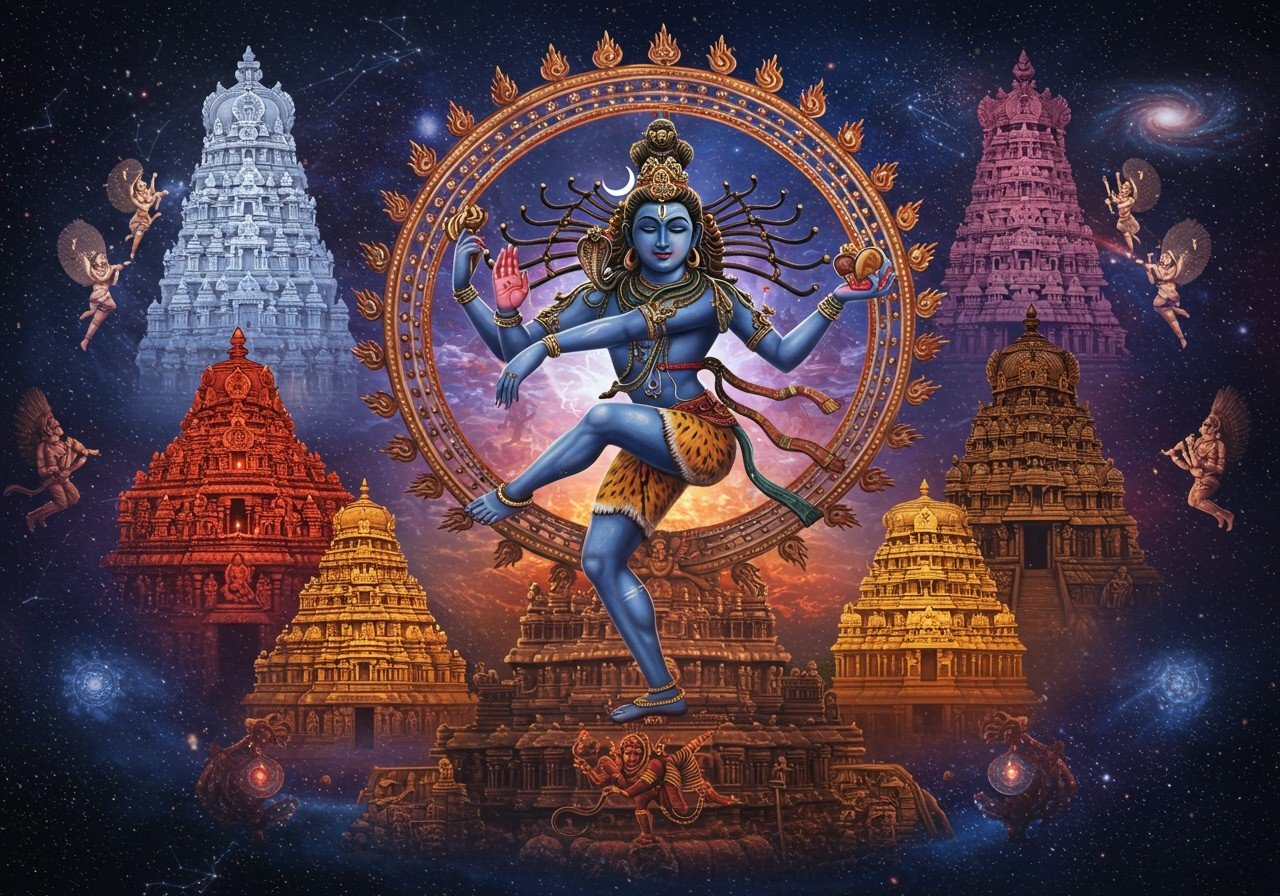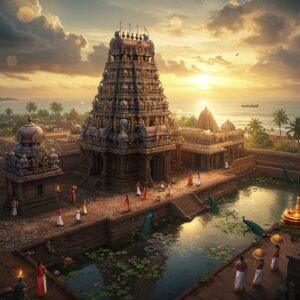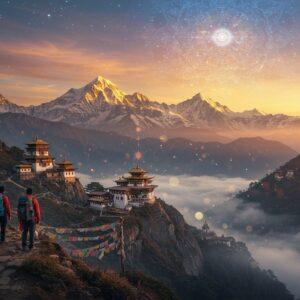
Lord Shiva, a deity deeply revered in Hindu mythology, is widely celebrated as Nataraja, the cosmic dancer. His divine dance is a powerful symbol of the universe’s continuous cycle of creation and destruction. The Pancha Sabhai, five sacred temples in Tamil Nadu, are revered as the places where Lord Shiva is believed to have performed this sacred dance. These temples hold profound cultural and spiritual significance for devotees, representing the rhythmic pulse of life and the dynamic energy of the universe.
The Pancha Sabhai Temples: Abodes of Shiva’s Dance
The Pancha Sabhai refers to five temples, each uniquely associated with a different metal, holding deep meaning within the Shaivite tradition. Let’s embark on a virtual journey to these sacred sites:
- Chidambaram Nataraja Temple (Gold): This temple, renowned for its magnificent gold-plated roof, is a central hub of Shiva worship. Its breathtaking Dravidian architecture stands as a testament to centuries of devotion.
- Madurai Meenakshi Amman Temple (Silver): Famous for its intricately sculpted pillars, this temple embodies the essence of silver. It serves as a vital cultural center, drawing devotees and art enthusiasts alike.
- Thiruvalangadu Ratnasabhai (Ruby): This temple, associated with the radiant ruby, is cherished for its tranquil atmosphere and exquisite carvings. It offers a sanctuary for peaceful reflection and spiritual rejuvenation.
- Tirunelveli Nellaiappar Temple (Copper): Known for its representation of copper, this temple boasts a rich history and mesmerizing musical pillars. The resonant sounds add another layer to the spiritual experience.
- Kutralam Kurumpalanathar Temple (Iron): This temple, representing the strength of iron, is nestled amidst the serene beauty of nature, offering a spiritual haven for those seeking solace and connection with the divine.
Each of these temples contributes a unique narrative to the story of Shiva’s cosmic dance, weaving together historical significance, architectural splendor, and profound spiritual meaning.
Delving into the Cosmic Dance of Shiva
Shiva Nataraja, often hailed as the “Lord of the Dance” or “King of Dance,” is a captivating depiction of Lord Shiva. Picture him in a dynamic pose, enveloped by a vibrant halo of fire. This fiery arch symbolizes the potent cosmic energy, the universe in all its vastness, encompassing joy, sorrow, illusion, and reality, and the cyclical nature of existence. As we explore the depths of Shiva’s dance, its profound symbolism unfolds.
Shiva’s dance, known as the Tandava, transcends mere performance; it embodies the rhythmic pulse of the cosmos, the very dance of creation and destruction. In his upper right hand, he holds the damaru, a small drum that resonates with the primal sound of creation, the sacred “Om.” His upper left hand holds agni, the purifying fire, symbolizing the destruction of illusion and the dissolution of the ego.
This cosmic dance is more than just movement; it’s a profound philosophy. Shiva’s lower right hand forms the abhayamudra, a gesture of reassurance, offering protection and dispelling fear. Beneath his feet lies Apasmara, a dwarf-like figure representing ignorance and ego, which Shiva’s dance triumphantly subdues, signifying the victory of wisdom over darkness.
Shiva’s raised left foot points towards the heavens, offering refuge to souls seeking solace. This elegant posture beckons devotees to embark on a journey of self-discovery and spiritual growth. His flowing hair, adorned with a skull, a datura blossom, a crescent moon, and the cascading Ganga, embodies his omnipresence and divine grace. A cobra, a symbol of Shiva’s yogic power, gracefully coils around his torso.
Shiva Nataraja transcends artistic representation; it is a spiritual emblem, a powerful link between religion and art, seamlessly blending divine wisdom with cultural expression. Through unwavering faith in Shiva, devotees can attain moksha, liberation from the cycle of birth and death, transcending the material realm to embrace the spiritual.
Pancha Sabhai Sthalangal: A Pilgrim’s Path
Embarking on a pilgrimage to the Pancha Sabhai temples is more than just a journey; it’s a profound exploration of spirituality and culture. Begin at the Chidambaram Nataraja Temple, where the golden roof shimmers under the sun, its Dravidian architecture whispering tales of devotion and artistic mastery.
Continue to the Madurai Meenakshi Amman Temple, where the silver accents on the sculpted pillars narrate stories etched in time. Immerse yourself in the vibrant local festivals, rich with color and heartfelt rituals.
Find serenity at the Thiruvalangadu Ratnasabhai, enveloped in a ruby aura, where intricate carvings speak volumes to the soul. The Tirunelveli Nellaiappar Temple awaits with its copper tones and musical pillars that resonate with history. Finally, seek refuge in the natural beauty surrounding the Kutralam Kurumpalanathar Temple, a sanctuary of iron strength and spiritual peace.
As you traverse these hallowed grounds, immerse yourself in the local ceremonies honoring Shiva’s cosmic dance. Pilgrims often experience profound personal transformation along this sacred path, forging a deeper connection with tradition, attaining spiritual enlightenment, and embracing the rich tapestry of cultural heritage.
The Enduring Cultural Significance of Shiva’s Dance
The reverberations of Shiva’s cosmic dance echo through Indian art and literature. Dancers of Bharatanatyam and Kathakali embody Nataraja’s grace and power, their movements a living tribute to this divine form. Sculptures capture Shiva’s essence in dynamic poses, inspiring creativity and artistic expression for generations.
Shiva’s dance profoundly influences Indian philosophy, serving as a constant reminder of life’s cyclical nature, its ebb and flow. Even in contemporary culture, this ancient dance continues to inspire modern practices and beliefs, bridging the gap between past and present.
Shiva Nataraja stands as a beacon of cosmic energy, symbolizing the triumph of the spiritual over the material. This divine dance continues to connect and inspire devotees across generations, offering solace, wisdom, and a glimpse into the eternal.
Preservation and Modern Relevance
Even as the world modernizes, dedicated efforts are underway to preserve the Pancha Sabhai temples. Local communities and government bodies play crucial roles in maintaining these sacred sites, ensuring that future generations can experience their spiritual and cultural significance.
Shiva’s cosmic dance remains deeply relevant in today’s world, offering profound spiritual insights to a global audience. As ancient traditions intertwine with contemporary interpretations, this timeless symbol continues to enlighten hearts and minds. Sustaining traditional practices while embracing new meanings enriches our understanding of Shiva’s dance, a timeless reminder of life’s rhythm and the dynamic nature of the universe.
Connecting with the Divine through Poojn.in
At Poojn.in, we offer a thoughtfully curated selection of authentic puja items to enhance your worship of Lord Shiva in all his divine forms, including the revered Nataraja aspect. Our collection includes:
- Exquisite pure brass Nataraja idols in various sizes, crafted with intricate detail.
- Traditional bell metal Shiva statues, imbued with sacred resonance.
- Panchamukhi (five-faced) Shiva lingams, representing Shiva’s all-encompassing presence.
- Pure copper abhishek items for sacred rituals, ensuring purity and authenticity.
- Rudraksha malas for japa and meditation, enhancing your spiritual practice.
- Premium quality dhoop and agarbatti to create a sacred atmosphere.
- Brass and silver puja thalis, beautifully crafted for your devotional offerings.
We offer secure, pan-India delivery to maintain the sanctity of your puja items. Our knowledgeable team is available to guide you in selecting the perfect items for your Shiva puja. Reach us at 03369029784 or connect with us on WhatsApp at 9476142738.
All our products are accompanied by authenticity certificates and are sourced from trusted manufacturers who adhere to traditional crafting methods. We are committed to providing competitive pricing while upholding the highest standards of quality.
For bulk orders for festivals or special occasions, we offer attractive discounts and customized packaging options. Visit Poojn.in to explore our complete collection of Shiva puja items or consult with our customer service team for personalized recommendations.
Embracing the Eternal Dance
As we conclude our exploration of Shiva’s cosmic dance and the sacred Pancha Sabhai temples, let us embrace the timeless wisdom and spiritual richness they offer. Shiva Nataraja, through his dynamic dance, imparts profound teachings about creation, destruction, and the eternal cycle of life. This divine dance serves as a bridge between the past and the present, guiding us towards balance and harmony in our lives.
Pilgrimages to the Pancha Sabhai temples deepen our connection to tradition and spirituality, reminding us of the intricate cultural tapestry that binds us as a community, celebrating both the old and the new. Through these sacred journeys, we embark on a path of personal transformation and spiritual enlightenment.
In the midst of modern life, preserving these temples and their stories becomes even more vital. They are not mere relics of the past, but living symbols that continue to inspire and guide us. Shiva’s cosmic dance resonates deeply in today’s world, offering profound insights and inspiration to people across the globe.
By honoring Shiva’s eternal dance, we honor the rhythm of life itself and the dynamic nature of the universe. It is a call to embrace spirituality amidst the material world, finding peace and wisdom within the cosmic cycles that surround us. Let us cherish this divine dance in our hearts, carrying its lessons forward for generations to come.
Understanding the Pancha Sabhai and Shiva’s Cosmic Dance
Many wonder about the significance of the Pancha Sabhai and Lord Shiva’s cosmic dance. The Pancha Sabhai isn’t just a collection of temples; they are the sacred stages where Lord Shiva performed his Ananda Tandava, his cosmic dance of bliss. Located in Tamil Nadu, these five temples—Chidambaram, Madurai, Thiruvalangadu, Tirunelveli, and Kutralam—hold immense significance in Shaivism.
Lord Shiva’s dance is more than just a performance; it is a symbolic representation of the universe’s cyclical nature, of creation and destruction, mirroring the rhythm of life, death, and rebirth. Each Sabhai holds unique significance based on the specific form and elements of Shiva’s dance performed there. For instance, Chidambaram is revered as the Kanaka Sabhai, the Golden Hall, symbolizing the radiant energy of creation.
Nataraja, the depiction of Lord Shiva as the cosmic dancer, is intrinsically linked to the Pancha Sabhai. These sacred halls are where Shiva manifested as Nataraja, performing his divine dance. Various festivals are celebrated at these temples, with Arudra Darshanam, commemorating Shiva’s cosmic dance, being one of the most prominent. Devotees often embark on pilgrimages to all five temples, seeking blessings and experiencing the divine energy that permeates these sacred sites.
Traditional rituals performed at these temples include abhishekam (sacred bathing), archanai (offering of prayers), and special pujas dedicated to Lord Shiva and his cosmic dance. These rituals hold deep spiritual meaning for devotees, connecting them to the divine energy of Lord Shiva. Visiting these temples and participating in these rituals can deepen one’s understanding of and connection with Lord Shiva’s cosmic dance.


